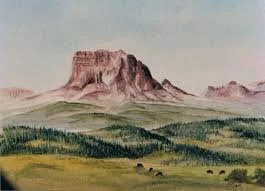The beautiful hamlet of
Leavitt
Leavitt
Originally called “Buffalo Flats”, reflective of the herds which grazed here in large numbers and hunted by Blackfoot people for centuries, Leavitt is a hamlet nestled in a picturesque valley, 13 kms west of Cardston on Highway 5, overseen by the grand Chief Mountain. Thomas Leavitt was one of the original pioneers who arrived at Lee Creek, present day Cardston in 1887. At the time, the land west of Cardston and north of Lee Creek under a long-term lease to a large cattle rancher, and those who had staked their claims for homestead had to wait until the lease expired. On July 23, 1893 Francis Broadbent and his three sons, Charles, Levi and Hiram registered their land claim and others soon followed.
Thomas Rowell Leavitt and his family were one of the first in the new community. , for which the community was named . To purchase their original land cost $1/acre or $60/quarter section. In 1896, Leavitt and others built the first church building which also served as a school and community centre. It was reported that prior to WWI, the school serviced 8 grades for ages 5-16 and accommodated 25 students.
Charles Card, the founder of Cardston, organized mail service in 1887-88 and Leavitt received its first post office in 1900. Thomas Jr., Frank and William Leavitt started the first store – Leavitt Brothers Grocery & Dry Goods in 1902. Telephone service arrived in the area in 1912.
The Spanish Flu hit Lethbridge in October 1918 and spread throughout the area and the story goes that one person attending a New Year's dance infected most of the residents of Leavitt. By April 1919, the flu was in recession.
The Great Depression forced residents to barter their produce for services and Mathew Leavitt reported farm laborers were paid $1/day to work beet and hay fields. Wheat was selling at 19 cents/bushel, dressed hogs at 6 cents/pound and heifers went for $20. The people of Leavitt were reported to be the most united than ever during those difficult years.
Leavitt began its own system of irrigation by 1939. Electricity arrived around that same time although some families had electricity using wind chargers.
Today, the hamlet remains small but prosperous and probably as beautiful as the vision Thomas first had upon viewing the valley.
References: Leavitt, The Valley I Call home 1893-2018; Leavitt by Community Historical book Committee
